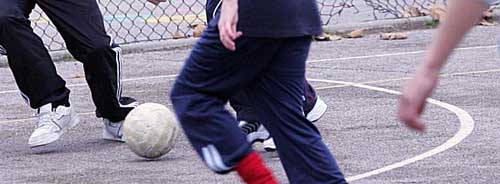
There has been a lot of nonsense written about Manchester United coming to the end of a ‘long, hard season’ recently. Frankly, 66 games is not a long season.
At school, matches began before school started at 9 o’clock. They continued through morning break, entered their Battle of El Alamein stage during the lunch hour, and then meandered on indefinitely after school. This happened five days a week, with two 11-a-side matches at the weekends. There were no subs, no squad rotation, no injuries and no summer break. That’s a proper season.
Of course playground rules are slightly different to those used in the Premiership, and playground football is all the better for it. In case it’s been a while since you hung up your blazer, here’s a quick guide to the most important regulations.
Picking teams
As everyone knows, teams are picked by the two captains – the owner of the match ball and his best mate. All the other combatants line up against a wall and are selected in descending order of perceived footballing skill and social popularity.
Tactics
Managers in the school games traditionally employ the 1-25 formation. The 1 being the hapless goalkeeper and the 25 being everyone else in the year scrapping in a 10-yard radius around the ball.
Rush goalkeepers
A novel way of appeasing the boy press-ganged into going in goal. Once appointed rush goalie, the boy is also allowed to take part in the outfield action when his other duties allow. Generally found leading the attack within 10 minutes of kick-off.
Monkey rush
A variation on rush goalie, monkey rush allows the post of goalkeeper to be filled by whoever is standing closest to the goal. Invariably leads to confusion and violence.
The goals
Goals are generally marked by any two landmarks a suitable width apart – fence posts, dustbins, soon-to-be-destroyed-saplings etc. In emergencies they can, of course, also be marked by the placing of two jumpers. The distance between said jumpers should always be sombrely paced-out by taking an arbitrary and entirely random number of steps.
The height of goals varies, depending on a complex equation involving the height of the goalkeeper and whether he chooses to jump or not as the shot flashes past him. In an interesting twist, the relative size of the young thug who took the shot can also have an important bearing.
Post and in
Another complicated ruling made necessary by the often bulky nature of the posts. A shot that passes goal-side of the post is generally determined to have gone ‘post and in.’ Shots passing over the outer side of the post are ruled ‘post and wide.’ Again, disputes and violence will follow.
The match ball
At middle school the ball of choice was a size-two World Cup ‘94 replica that McDonald’s gave away with Happy Meals. Small, and with the firmness of a composite hockey ball, they suited skilful dribblers and hopeless toe punters alike.
Other suitable balls include: floaty ‘Match’ ball from newsagents, tennis ball, Nike Air Jordan basketball, size three Puma King (£14.99 from Argos), year four boy’s graphic calculator.
Offside
Playground football doesn’t feel the need to criminalise players who lurk offside. Instead it relies on social ostracism to self-police the problem. Anyone found standing next to the goalkeeper for more than 20 seconds is instantly dubbed a goal-hanger and doomed to the status of pariah for ever more.
Beats
Another form of self-policing. Beats can be dished out for offences as varied as kicking the ball over a fence, failure to successfully complete the Baggio Seven or the late onset of puberty.
The seriousness of the beats reflect the offence. A minor transgression warrants a stiff jab to the BCG, while more serious crimes necessitate a brutal kicking against a chain link fence.
Fouls
Are you joking? Don’t be such a girl.
